
On the morning of Monday, 3rd March, various NGOs and individuals had a meeting in Douliou City before going to visit the Hushan Dam site later in the day. Amongst others were Taiwan National Coalition Against the Hushan Dam (TNCAHD) representatives from Taiwan Environmental Protection Union (TEPU), Wild at Heart Legal Defense Association, Taiwan Academy of Ecology, and Wild Bird Society of Yunlin.
At 13:30 NGOs, press and concerned individuals met with the Central Region Water Resources Office (CRWRO) of the Water Resources Agency at their offices in Hushan. What follows are some general impressions and observations made by a TNCAHD member present.
The Central Region Water Resources Office hosted a meeting/presentation in an old classroom in the former Trans-World College Campus in Hushan. Central Region Water Resources Office Deputy Director, Chiang Ming-Lang, seemed to be in charge of proceedings and stood handing out business cards while for a time a large image of the Taipei 101 building appeared on the presentation screen in the meeting room as the visitors arrived.
Chiang and his office seemed ill prepared for the for the presence of members of the international community. No interpreter was available nor was any non-Mandarin material or information available. Considering the international interest in the Hushan issue and the considerable numbers of letters of concern sent to the Taiwanese Government by large international groups like BirdLife International, The Royal Society for the Protection of Birds (RSPB), The Humane Society International (HSI), and National Resources Defense Council (NRDC) this was the first in a number of observations that tended to give the impression of a very inward looking and closed-minded attitude of the CRWRO in their dealings with NGOs and other non-governmental individuals or groups. English has been called the unofficial "second language" of Taiwan. Some government departments religiously prepare some English material for presentations where they know or expect foreign involvement but this differs from department to department.
At the presentation the thirty-strong visiting group, made up of concerned individuals and members of the press and NGOs, seemed to be almost outnumbered by seemingly uninvolved CRWRO and Taisei Corporation workers. During the presentation a number of these people would walk in and out of the classroom and would gather in small groups outside smoking and chatting while staring through the windows at the visitors. Was this perhaps an attempt at intimidation or just too many under-worked CRWRO bureaucrats with nothing better to fill their day with than the opportunity of staring at all the environmentalists that had come to view their handiwork? 
The presentation included slides of officials allegedly saving creatures, such as the endangered Yellow-margined Box Turtle Cuora flavomarginata flavomarginata, and a number of indigenous plants. The attitude seemed to be one of, "You see ! We did it right ! We helped save all those little creatures you were so worried about. We know we didn't let you come and watch us because we didn't want you interfering with our important development but trust us, we know what we're doing so what was all the fuss about?"
The Presentation
After the presentation the visitors were handed bright yellow hardhats. Our CRWRO and Taisei hosts wore red or orange ones. Visitors were then put on bus and a minivan and escorted by a few private cars, were driven to the dam site. The vehicles whizzed past workings that our hosts had obviously decided were not to be viewed regardless of whether we had an interest in these specific working areas or not. The full impact of a cleared Hushan was quite a shock. Hills stood treeless and clear of vegetation. Much of Hushan, as we knew it, now lay in ruins, gone forever !
Visitors were taken to only two working areas. At the second area an official working on the "conservation" and "rehabilitation" of the area lamented to the media how environmentalists continually interfere with his work. Quite how environmentalists interfere with his work on a site that they are bared from entering was not explained. The concept of non-governmental-parties having concerns for what was being done behind closed doors on the site and how it was being done didn't seem to be a legitimate reason to question his work. He clearly seemed to think he was only accountable to government and the developers. The fact that a considerable some of money, around 200 million NT Dollars, has been earmarked for "conservation" and "rehabilitation" on the project and that the public should have a right to know how that money is being spent, again, didn't appear to count for very much. 
Visitors were then taken to an area outside the construction area and shown a very small cleared area set amongst exotic bamboo and betel nut palms. Within the cleared area totaling a few hundred square metres, if that, were a few plants. This, we were told, was what they had saved from the construction site. We were made to understand that some trees still had to be moved but somehow, after having viewed the hundreds of hectares of cleared land, these few plants didn't seem very much.
The saved plants
Click for site visit photos.
Also see:
Reflections on the destruction at Hushan on the Wild at Heart website.
The destruction continues
Friday, March 7, 2008
Hushan Dam: NGO site visit
Posted by
Wild at Heart Legal Defense Association
at
12:46 PM
![]()
Subscribe to:
Post Comments (Atom)


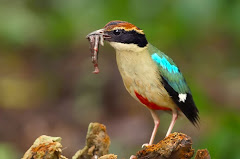



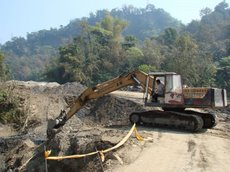
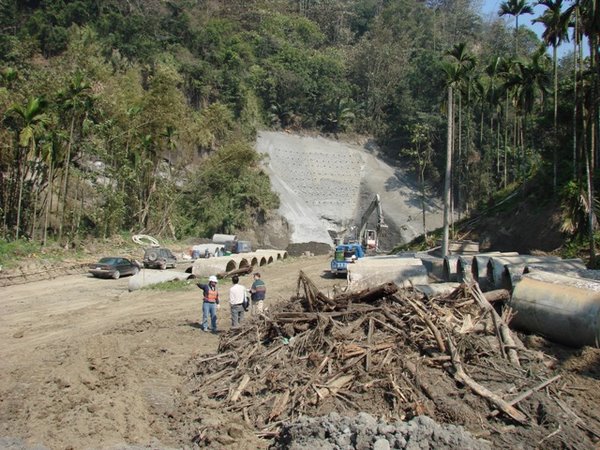
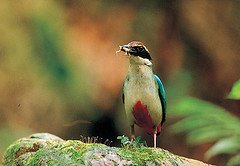
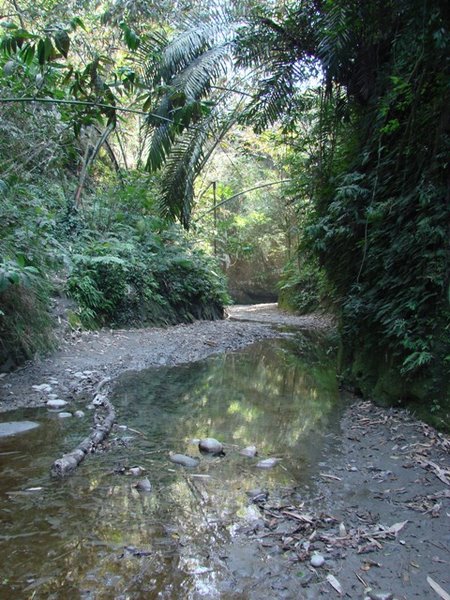
No comments:
Post a Comment